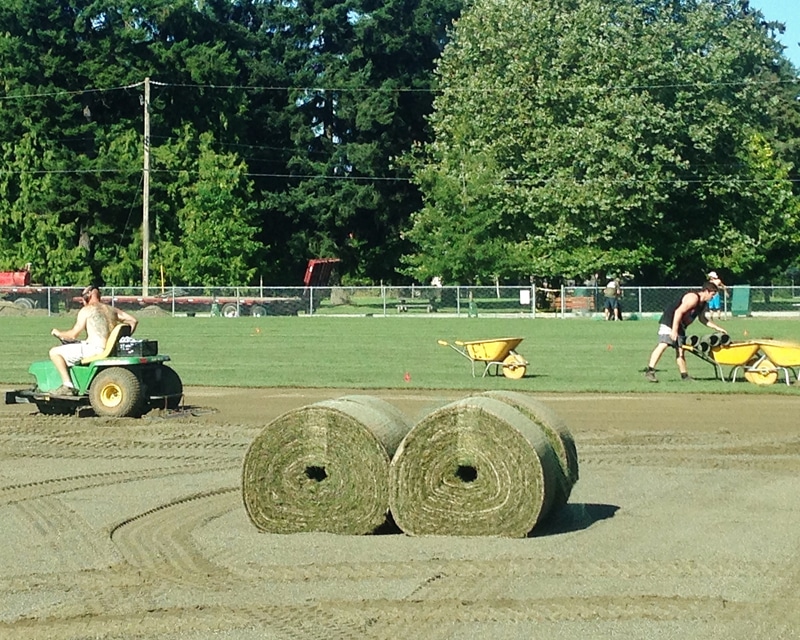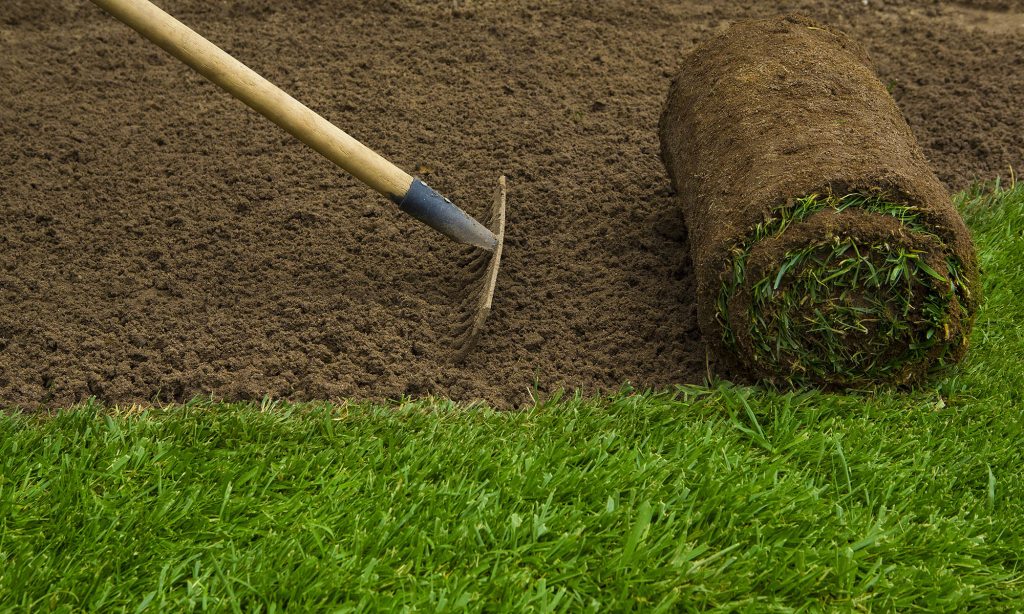Big Roll Sod for Large Projects
Commercial Sod Installation:
The Smart Choice for Large-Scale Projects

Why Large-Scale Sod Installation Matters
Managing large commercial landscapes like golf courses, sports fields, municipal parks, and boulevards requires expertise and precision. These high-traffic areas need a reliable, aesthetic, and durable sod solution that ensures long-term functionality. Traditional sod rolls, while effective for small-scale projects, fall short when it comes to efficiency and durability for large spaces.
This is where Big Roll Sod comes in. Designed for large-scale commercial sod installation, Big Roll Sod provides a faster, seamless, and more cost-effective approach to turf establishment. Whether you’re managing a sports field, golf course, or public park, Big Roll Sod minimizes seams, cuts down on labour, and ensures efficient installation with machine-driven precision.
Let’s dive into the benefits of commercial sod installation, the advantages of Big Roll Sod, and why it’s the top choice for large-scale projects.Looking for professional sod installation services?
Learn more about our expert solutions here: Sod Installation Services.
Why Choose Commercial Sod Installation?
The Importance of Quality Turf for Large-Scale Projects
A well-installed sod system is crucial for commercial landscapes for several reasons:
- Enhances visual appeal – A lush, green lawn improves the aesthetics of golf courses, sports fields, and parks.
- Boosts functionality – High-quality sod provides a safe and durable playing surface for athletes and visitors.
- Saves maintenance costs – Professionally installed sod is more resistant to wear and tear, reducing ongoing repair costs.
- Improves efficiency and cost-effectiveness – Big Roll Sod is quicker to install, reducing labour costs and allowing for faster project completion.
Big Roll Sod vs. Traditional Sod Rolls:
| Feature | Big Roll Sod | Traditional Sod Rolls |
|---|---|---|
| Installation Time | Fast (Machine-driven) | Slow (Manual labour) |
| Seam Visibility | Minimal seams | More seams, visible patches |
| Durability & Root Health | Stronger root integration | Takes longer to establish |
| Labour Efficiency | Requires fewer workers | Labour-intensive |
| Ideal for Large Areas | ✅ Yes | ❌ No |
For commercial-scale sod installation, Big Roll Sod offers the most efficient and cost-effective solution.
Need a professional sod installation team? Learn more about our process: Sod Site Preparation.
Our Commercial Sod Installation Process
1. Site Assessment & Preparation
Before installation, we conduct a thorough site evaluation to ensure optimal sod growth:
✔ Analyze soil type to determine drainage requirements.
✔ Clear debris and level the area for a smooth installation process.
✔ Check for irrigation to support long-term sod health.
2. Sod Selection & Supply
Choosing the right sod variety is crucial. Sod Crew provides:
✔ Premium sod tailored to your region’s climate.
✔ High-traffic-resistant grass varieties for sports fields and golf courses.
✔ Delivery options for self-installation or full-service installation.
3. Big Roll Sod Installation
✔ Machine-driven process ensures even sod placement.
✔ Seamless integration with fewer gaps and patches.
✔ Efficient installation reduces labour costs and project timelines.
4. Post-Installation Care & Maintenance
After installation, we provide expert advice on post-installation care:
✔ Proper watering schedule for root establishment.
✔ Fertilization and mowing guidelines to maintain sod health.
✔ Ongoing turf care plans for long-term durability.



Custom Sod Supply & Installation Packages
Sod Crew offers customized solutions for every large-scale sod project:
1. Sod Supply Only
- High-quality sod delivered to your site.
- Ideal for landscapers, contractors, and municipalities managing their own installation.
2. Full-Service Sod Supply & Installation
- Professional site preparation and sod installation.
- Post-installation care to ensure strong root establishment.
3. Custom Packages
- Tailored for specific project needs (e.g., golf courses, stadiums, public parks).
- Flexible options based on project size and budget.
Get a custom sod installation quote today!
Benefits of Big Roll Sod for Large-Scale Projects
1. Fewer Seams, Stronger Turf Integration
Large sod rolls reduce visible seams, resulting in a seamless, professional appearance. This improves:
✔ Uniformity of playing surfaces (essential for sports fields).
✔ Stronger root systems, preventing gaps and uneven patches.
2. Time & Labour Efficiency
Big Roll Sod is machine-installed, reducing labour costs and project timelines. Fewer workers are needed, making installation:
✔ Faster and more precise.
✔ Less physically demanding, minimizing workforce fatigue.
3. Immediate Usability & Longevity
Unlike seeded grass, sod establishes quickly. Big Roll Sod is:
✔ Traffic-ready within weeks.
✔ More resistant to wear and tear than seeded turf.
4. Sustainability & Environmental Benefits
A well-installed sod system improves environmental sustainability by:
✔ Preventing soil erosion.
✔ Enhancing stormwater absorption, reducing runoff.
✔ Requiring fewer pesticides compared to seeded lawns.
Industries We Serve
✔ Golf Courses – Premium sod for greens, fairways, and club landscapes.
✔ Municipal Parks & Public Spaces – Safe, resilient turf for public areas.
✔ Sports Fields & Stadiums – High-performance sod for sports teams.
✔ Commercial Landscaping – Aesthetic, low-maintenance sod solutions.
Frequently Asked Questions (FAQs)
1. What are the benefits of Big Roll Sod over traditional sod rolls?
Big Roll Sod has fewer seams, faster installation, and better durability for large-scale projects.
2. How long does it take to install sod for a commercial project?
Most large-scale sod installations take 1-2 days, depending on the project size.
3. What’s the best type of sod for high-traffic sports fields?
We recommend drought-resistant, deep-rooted sod varieties designed for heavy use.
4. Can you provide sod supply only, or do you handle full installation?
Yes! We offer both sod supply and full-service installation options.
5. What maintenance is required after sod installation?
Proper watering, mowing, and fertilization are essential for long-term sod health.
6. How soon can commercial sod be used after installation?
Most sod is ready for light use within 2 weeks and full use within a month.
7. Does commercial sod require special irrigation or drainage preparation?
Yes, proper drainage and irrigation ensure the sod establishes strong roots quickly.
Get Expert Commercial Sod Installation Today!
At Sod Crew, we specialize in large-scale sod installation for golf courses, parks, sports fields, and municipal projects. Whether you need Big Roll Sod supply or full-service installation, we have the expertise and equipment to get the job done efficiently.
📞 Contact us today for a free consultation!
For quickest response, please text 778-809-0506 for a call back, otherwise complete the form below.
If you are having trouble completing this form, please email us at sales@sodcrew.com.
